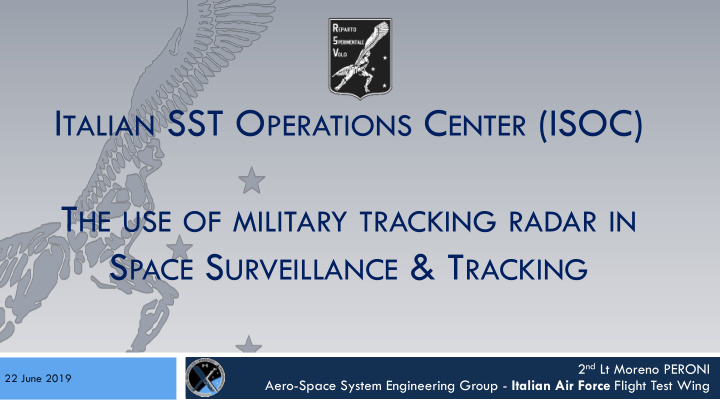



I TALIAN SST O PERATIONS C ENTER (ISOC) T HE USE OF MILITARY TRACKING RADAR IN S PACE S URVEILLANCE & T RACKING 2 nd Lt Moreno PERONI 22 June 2019 Aero-Space System Engineering Group - Italian Air Force Flight Test Wing
Agenda Space Debris & Space Surveillance and Tracking (SST) Italian SST Operations Center (ISOC) Test cases, outputs & results Conclusions
Space Surveillance & Tracking 3 IRIDIUM-COSMOS collision From Sputnik 1 launched in 1957, more than 8,000 spacecraft were placed in orbit. FENGYUN ASAT test Many aspects of our daily life may suffer the consequences of Voluntary reduction interaction of orbit structures with spatial debris. [Credit: NASA]
Why SST? 4 • Increasing need to protect spatial structures of national / EU interest from impacts with debris (consequences on navigation services, TLC, etc.) and to ensure access to space; • Estimating the risk of collision through national SST capabilities, enabling satellite operators to plan mitigation Example of recent 1mm debris damage to Copernicus measures and prevent the proliferation Sentinel-1A satellite [Credit: ESA] of spatial debris.
Italian SST Operations Center ( ISOC) 5 ISOC mission overview: Hub for the national SST sensors network (radar, optical, laser) of ItMoD/ITAF/ASI/INAF; Tasking of sensors; Data processing for orbit determination (OD); Generates and provides services for Conjunction Analysis, Re-entry and Fragmentation; Develop a national object catalogue.
ISOC: C2 Chain • RE and FG services provision • ISOC is currently in charge of CA service only for national satellites
ISOC: SST Sensors Architecture ISOC
Test case: Sensor MFDR Radar: Weibel Multi Frequency Doppler Radar (Phased Array) located in Sardinia (PISQ military base) Power: 320 Watt Objectives • Demonstrate the capability to track a space object • Demonstrate the data quality goodness to ensure orbit determination (OD)
Test case: MetOp-B satellite • NORAD ID 38771 • Launched in 2012 • Mass 4.000 kg • Size 17.6 m x 6.7 m x 5.4 m • RCS ≈ 13.7 sqm • Orbit Altitude ≈ 800 km (circular) • Orbit Inclination 98.7° Meteorological satellite with main task to measure temperature and humidity of the [credit: ESA – AOES Medialab] atmosphere, clouds, wind speed at sea level and ozone layer
Analysis 10 The analyses performed by ISOC started with a comparison Radar Measurements High quality Ephemeris (reference) converted in TDM format
Passage comparison
Measurements Residuals 12 Measurement Residuals shows small dispersion but: - some problems in azimuth (blue dots) in the last part of acquisition - white noise, expecially in the range (red dots)
Measurements Residuals 13 After a filtering process the Residuals shows smaller dispersion
Orbit Determination Step Step 0 1 Satellite measurements Initial Orbit Determination Step 2 Least Square Filter Step 3 Kalman Filter Step ephemeris file 4 & Smoother covariance
Output & results 15 Position uncertainty shows small covariance matrix
Output & results 16 OD ~ 750 m ~ 880 km slant range REF. Geometry of observation – Orbit from OD and from reference
Conclusions Italian Air Force deeply involved in SST, performing data fusion from optical and radar sensors Radars are a fundamental component for SST Further tests and analyses are required in order to assess both other systems bias and systems characterization (e.g. ionospheric corrections, RCS vs Range)
Questions? moreno.peroni@aeronautica.difesa.it
Recommend
More recommend